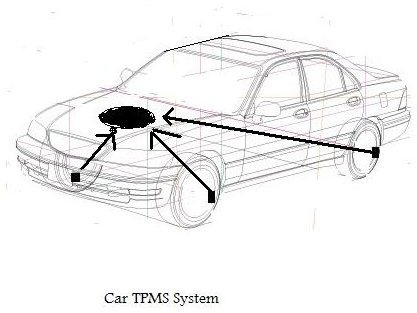How Tire Pressure Monitoring and Warning Systems Work
The Need for Tire Pressure Monitoring/Warning Systems
Before you start driving your vehicle, you should check the tire pressure. It should be kept near its nominal value or as mentioned by the tire manufacturer. Usually this information can be found in the owner’s manual or in a sticker on the door jamb.
Variations in tire pressure can cost you. In general, increasing the tire pressure will help the vehicle overcome road friction more easily, thus reducing fuel consumption at any particular speed, and allowing the vehicle to carry more weight. However, the tire pressure should not be allowed to exceed the maximum limit specified by the car or tire manufacturer. A too-high tire pressure can lead to a dangerous blow-out.
If tire pressure is lower than the specified limit, it can cost you, too. Low pressure increases tire friction, and your vehicle has to consume more fuel to overcome this friction. If tire pressure is kept low for a long time, it will increase the wear and tear on the tire, thus shortening tire life.
From the above discussion we see that one should check tire pressure on a regular basis, which can be wisely concluded to be around twice a week.
At this point, you may be wondering how air escapes from a tire. Actually there are numbers of small holes (in the order of microscopic levels) in the tire casing and small gaps where the tires touch the rims, and air molecules escape through these tiny holes.
Types of Tire Pressure Monitoring Systems
Two main techniques are currently in use in tire pressure monitoring systems:
- Direct method.
- Indirect method.
Direct method: In this method sensors installed on all four tires send data to the main computer of the vehicle. Theses sensors measure tire pressure directly, which is then transmitted by radio-frequency microwaves to the main computer for displaying on the dash. This method of measuring tire pressure is very efficient.
Indirect method: In this scheme sensors mounted on the rims of the tires sense the speed at which your tire is spinning and compare it with speed at which it should rotate. If your tire is spinning faster than it should be, it indicates that the tire has a reduced diameter and, thus, low pressure.
Advantages and Disadvantages of Tire Pressure Monitoring Systems
Drawbacks of TPMS Systems
- The TPMS sensor contains a lithium battery to power up the sensor electronics including the radio transmitter. The average life of this battery is 4-7 years, and once battery dies, it needs to be replaced.
- Sensors are installed on the rim, so it becomes difficult to remove the tire from rim.
Benefits of TPMS for the Car Owner
- Through using TPMS, the car owner can get tire pressure information from readings on the dash.
- If the driver reads low pressure in tire, it can be increased to a maximum limit. It should not exceed the limit specified by the manufacturer. Tire friction with the road is greatly reduced when using the maximum allowable pressure. Less energy will be required to overcome friction. In this way the car owner will get the benefit of less fuel consumption.
- Extra fuel is consumed by engine- almost 1% for every 3 PSI under inflation.
- Similarly if the pressure in the tire crosses the maximum limit specified by the manufacturer, it becomes extremely dangerous, especially when you are travelling a long way with car heavily loaded. This high pressure can burst the tires into pieces- but with a TPMS system the driver constantly can keep an eye on his tire pressures.
- Tire pressure monitoring systems allow the car owner to carry the maximum allowable load.
References:
Orange Electronic TPMS - wireless TPMS sensors that replace tire schrader valves and read-out in the car (also for motorcycles)
Bartec Auto ID Ltd - tire pressure monitoring systems for automotive manufacturers/assembly lines
Hawkshead Systems - aftermarket replacement TPMS for RVs, cars, and trucks including high-pressure tire applications
